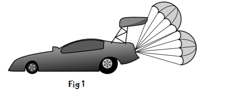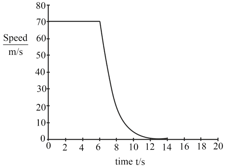Parachutes are used to slow down a certain racing car.
Figure 1 shows the racing car, of total mass , slowing down by using parachutes.

Figure 2 is the speed-time graph after the car reaches full speed.

At the time, the parachutes open.
(a) In Fig 1
(i) mark a point, labelled A, where the car is moving at a constant speed.
(ii) mark a point, labelled B, where the car is decelerating at a uniform rate.
(iii) mark a point, labelled C, where the car is decelerating at a non-uniform rate.
(b) Calculate
(i) the deceleration of the car at the time
(ii) the resultant force acting on the car at this time.
(c) Explain why there is no resultant force acting on the car at the time


Important Questions on Equations of Motion
A body starts from rest is accelerated uniformly for 30s. If x1, x2, x3 are the distances travelled in first 10s; next 10s and last 10s respectively, then x1 : x2 : x3 is

In the above graph what is the value of acceleration?
(Assuming that the acceleration is uniform)
Can we use equations of motion for motion having variable acceleration?
State which of the following situations are possible and give an example for each of these:
An object with a constant acceleration but with zero velocity.
State whether the following situation is possible and give an example for it: An object with a constant acceleration but with zero velocity.
Give an example of each.
(i) acceleration is in the direction of motion.
(ii) acceleration is against the direction of motion.
(iii) acceleration is uniform.
(iv) acceleration is non-uniform.
State whether the following situation is possible or not and give an example for the case.
An object with a constant acceleration but with zero velocity.
Equations of motion are used for uniformly accelerated motion only. Comment
Can be a body be accelerated, if it is moving with constant speed?
When do we say that a body is retarding or decelerating?

